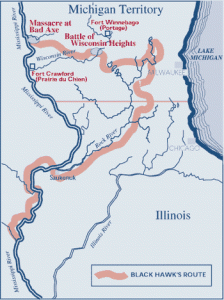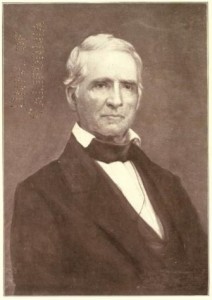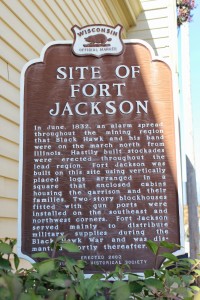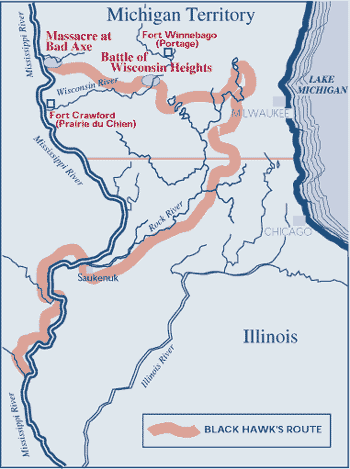Beginning of the Black Hawk War

Fort Jackson would never have been established if it weren’t for the Black Hawk War that took place from April 6, 1832 – August 27, 1832. The Black Hawk War originally started due to conflicts between the United States and the Native Americans such as the Sioux, Fox, Potawatomi, Lakota, and more regarding the Treaties of Portage des Sioux which were established in 1815, however every Native American chief signed the treaties except for Chief Black Hawk himself who was the leader of the Sauk American tribe at the time. The treaties were established to end the conflict between the two parties by restoring their way of life before the War of 1812 which included their rights, possessions and special privileges.
Nobody really understood the motives of Chief Black Hawk but his intent was to recapture the land the United States had claimed in the Treaty of St. Louis in 1804 without causing any bloodshed (8).It wasn’t until Black Hawk and his band of warriors from several different tribes including his own, crossed the Mississippi River into the Illinois Territory and tried to reclaim land where blood was finally spilled.
When the news broke of Black Hawk and his warriors attempting to move north into the Southwest region of Wisconsin, the settlers occupying this area had a drastic change in their way of life. One person who led the change and rebellion against Black Hawk was Henry Dodge who had a significant impact throughout the entire Black Hawk War (3, Pg.39). Henry Dodge who eventually became governor in the area was one of the first settlers in Iowa County who helped establish the settlement as a whole (1, Pg.26). It started off as a small settlement until a large amount of copper and lead was discovered in the ground and people started flooding to make a living off of mining. This included Dodge who purchased thousands of acres of land so his family could life a happy life. When word was received that the Indians could be on the move Dodge took matters into his own hands (3, Pg.45).
On May 14, 1832 Dodge and his two sons Henry RM, and Augustus set out on a scouting expedition accompanied by 27 other willing men to learn the movements of the foreseen enemy. It wasn’t until he approached the site of a previous battle that he knew his settlement and the people there were not safe (1, Pg.28). He duly took note of the situation and rushed home back to the mining settlements in order to warn the settlers and prepare for the oncoming threat. From there, several different defense companies were established and several forts also known as stockades were formed, and one fort in particular that was established was Fort Jackson which was located in in present day Mineral Point, Wisconsin (1, Pg.28).
Establishment of Fort Jackson
Forts were defensive barriers built around a town or settlement to protect the residing settlers from a possible threat. Fort Jackson was named after President Andrew Jackson who was also a former Indian fighter and due to the current situation was a suitable name (5, Pg.103). It is an interesting and different fort from the others such as Blue Mounds or Winnebago because of the way it was constructed. Unlike many forts in the area, there was little to no forest remaining in the area which was used for fueling furnaces from all of the mining that took place in past years (4 Pg.56). This created a shortage in lumber and caused problems trying to get the necessary material for the wall the settlers were trying to build around their town. Instead of traveling long distances in search for lumber which also required cutting, shaping and transporting the material, the settlers came up with a new idea that could simplify the process.
They decided as a whole to tear down the town and use the lumber from established buildings to create the wall around them. By doing this they eliminated the tedious tasks stated above and could build the fort in a shorter time period. The fort was created by placing thick and long logs in an upright position and placing them in the ground next to each in the shape of a square around the occupying area (7). So they could see who was going in and out of the fort they only had two entrances which were located on opposite ends on the Northwest and Southeast corners. In addition to the entrances there was also an accompanying blockhouse (7). A blockhouse is a small fortification made of wood or other materials and is similar to a watchtower. A blockhouse is the main defensive point for the fort and it had several outlook points so that the person or people in the tower can view over the wall to see if a threat might be approaching. These outlook points allowed the settlers to fire at the enemy from several directions and the buildings themselves were extremely effective against enemies that didn’t have any type of sieging equipment.
Role of Fort Jackson during the War

When the war started the fort created its own militia which was known as the Iowa County Michigan militia and consisted of 58 men under the leadership of John F O’Neal who were willing to protect the fort if it ever was invaded (6, Pg.34). Although the militia never saw battle during the war, the fort had a different impact on the United States winning the war. Another thing the fort did during the war was serve as a base for Henry Dodge’s mobile ranger group (6, Pg.27). This kept the soldiers in a position close to other forts so they could move out to other positions nearby if support was required during battle.
Although both of these things were important, the major purpose of Fort Jackson was its role as a main distribution center for government weapons, supplies and ammunition. Not only for their own militia and Dodge’s soldiers but to soldiers fighting Black Hawk on the front lines and other forts in the area that could be attacked (1, Pg.27). The main weapons that they were distributing were regular flintlock rifles and swivel guns. The majority of the rifles went to fighting soldiers and the swivel guns were sent to forts due to their purpose as defensive weapons. What made swivel guns different from regular rifles is that they were mostly large caliber flintlock rifles but were vastly oversized which made them hard to hold (9). They got their name because they had a swivel connected to them which allowed them to fire in all directions. They were a crucial factor when it came to defending a base because they were able to be mounted at the tops of fort walls. In the openings of blockhouses giving them an elevation advantage on the approaching enemy. There are several different types of swivel guns based on the types of ammunition the gun was supposed to fire. The three main types of ammunition used for these guns were grapeshot, roundshot, and cannonballs (9). Grapeshot was not used too often unless the enemy was close to the fort wall due to the spread of the projectiles and its distance it can travel accurately. The most common one was roundshot because it was a larger rifle bullet and cannonballs were mostly used when trying to take out a vast amount of soldiers. Roundshot was the most used because it was the most accurate type of ammunition and was easier to reload under the circumstances.
Fort Life during the War
The life of the settlers changed drastically from the months leading up to the war. Instead of being able to do all of their normal daily tasks without worrying, they were constantly on watch for the approaching enemy. However, the settlers were able to able to go in and out of the fort as they pleased but they put precautions in place in the event of an attack or a surprise ambush. Henry Dodge had a quote several years after the war that described what life was like after the war and he stated “Fathers were called to defend their own settlements, mothers and sisters molded bullets and carried water, filling barrels in order to have a supply during a possible future siege” (1, Pg.29). In addition to this he also commented that basic everyday tasks such as milking cows and worshipping god were conducted under the surveillance of armed men. This was incorporated into fort life because they didn’t want to risk the life of one settler and were ready to take the necessary precaution at any expense (1, Pg.29).
End of the Black Hawk War
The war only lasted a couple months and was near its ending after the Battle of Bad Axe that took place in present day Victory, Wisconsin that took place on August 1-2, 1832. This battle resulted in the most of the Indian warriors being captured or killed with a total count 75 being captured and about 175 being killed in action which also includes the non-combatants participating in the war (8). Although this is the final battle that took place during the Black Hawk War it does not mark the end of the war. During this battle Chief Black Hawk and several other leaders in his army escaped and were on the run. Eventually they were forced to surrender which resulted in the imprisonment of Black Hawk and his leaders with a one year sentence for his crimes during the war and fighting back against the U.S. The total casualty count of the war was not significant with a total of 77 deaths on the settler’s side and around 550 deaths on the Native side from several different tribes that were fighting (8). After the war Black Hawk continued living his life until he died from illness in Davis County, Iowa on October 3, 1838 (8). People knew him said that he was not the same person after the war. They stated that “Black Hawk had a strong personality before his spirit was broken by the defeat of the war, and even in his reserves and exile from his original native homelands he lived a quiet and secluded lifestyle who fretted his life away on the recks of St. Helena. (2, Pg.8)”
Fort Jackson after the War

Once the war was over and some time had passed Fort Jackson was no longer needed for its intended purposes and this resulted in the deconstruction of the fort completely. After the fort was torn down the settlers were trying to return to their normal way of life. In order to do this, they had to rebuild the town from the lumber they used on the fort but some of it went to fuel their furnaces they used when they were extracting ores from the ground. It didn’t come until 2 years later in the year of 1834 that the settlement found its true calling in the region (3, Pg.105). The settlement was selected as one of the two major land offices that the federal government chose. This established them as a new public land distributor within the former Michigan territory and they regulated what happened to the land in their county. In the present day there isn’t anything remaining of the fort’s history except for a small remembrance sign about when it was created and the purpose of the historic fort (7).
Primary Sources
- Salter, William. The life of Henry Dodge, from 1782 to 1833. Burlington, Ia, 1890
- Wisconsin Historical Society. Reminiscences of Black Hawk, by people who knew him. Wisconsin Local History & Biography Articles; “Newspaper”; “City”, “State”; “Article Date” Viewed online at 16 Nov. 2017
- Pelzer, Louis, Henry Dodge. The State Historical Society of Iowa, 1911
Secondary Sources
- Thawaites, Reuben G. Collections of the State Historical Society of Wisconsin. 12, Democrat Printing Company, 1892.
- Birmingham, Robert A. Life, Death, Archaeology at Fort Blue Mounds: A Settler’s Fortification of the Black Hawk War. Wisconsin Historical Society Press, 2012.
- Fiedler, George. Mineral Point: A History. Wisconsin Historical Society Press, 1962.
- Toman, William J . Site of Fort Jackson. Site of Fort Jackson, Historical Marker Database, 16 June 2016.
- “Black Hawk War | Historynet.” HistoryNet. N. p., 2017. Web. 17 Nov. 2017.
- Sanchez, Isai, Pre 1800’s Cannon Research. 2011. Web. 7 Dec. 2017.

